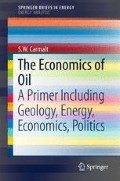Abstract
The history of the oil industry is one of gluts followed by concerns over future supply. Major oil discoveries have tended to flood the market with supplies far in excess of demand. But the resulting low prices increase demand, and as the oil stops gushing out of the wells there is concern about shortages.
Access this chapter
Tax calculation will be finalised at checkout
Purchases are for personal use only
Notes
- 1.
As quoted in Ahlbrandt (2012).
- 2.
See Aleklett (2012) p. 10 for a history of the term.
- 3.
Kuykendall (2005) has compiled a bibliography of Hubbert’s publications. See http://www.hubbertpeak.com/hubbert/bibliography.htm. Accessed 2014-09-02.
- 4.
Notably those of Lewis Weeks, chief geologist of Standard Oil of New Jersey (now ExxonMobil).
- 5.
Kansas has been very thoroughly explored for oil. This allows statistical forecasting methods to be tested against known results.
- 6.
Deffeyes states that the uncertainty in the analysis is ±1 month, allowing him to choose US Thanksgiving Day of 2005 as the actual date of peak oil (Deffeyes 2005, p. 43).
- 7.
A conference in 1974 (for proceedings see Haun (ed) 1975) was held at Stanford University on the subject of ‘Methods of Estimating the Volume of Undiscovered Oil and Gas Resources’. Hubbert was conspicuous by his absence.
- 8.
Referred to as 1P, 2P and 3P reserves, with 1P being the proved reserves.
- 9.
Securities and Exchange Commission, which regulates securities trading in the USA.
- 10.
See Financial Standards Accounting Board ASU 2010-03 (FASB 2010).
- 11.
See Aleklett (2012) p. 10 for a history of the term.
- 12.
Petroconsultants collected and compiled data from the exploration and production sector of the oil industry for much of the world, and then sold the compilations back to the oil companies. The company has since been acquired by IHS, which continues the activity.
- 13.
At least it hadn’t as of the end of 2015.
- 14.
See Owen (2010) for a precis with commentary of Jevon’s paradox.
Author information
Authors and Affiliations
Corresponding author
Rights and permissions
Copyright information
© 2017 The Author(s)
About this chapter
Cite this chapter
Carmalt, S.W. (2017). Peak Oil. In: The Economics of Oil. SpringerBriefs in Energy(). Springer, Cham. https://doi.org/10.1007/978-3-319-47819-7_4
Download citation
DOI: https://doi.org/10.1007/978-3-319-47819-7_4
Published:
Publisher Name: Springer, Cham
Print ISBN: 978-3-319-47817-3
Online ISBN: 978-3-319-47819-7
eBook Packages: EnergyEnergy (R0)

